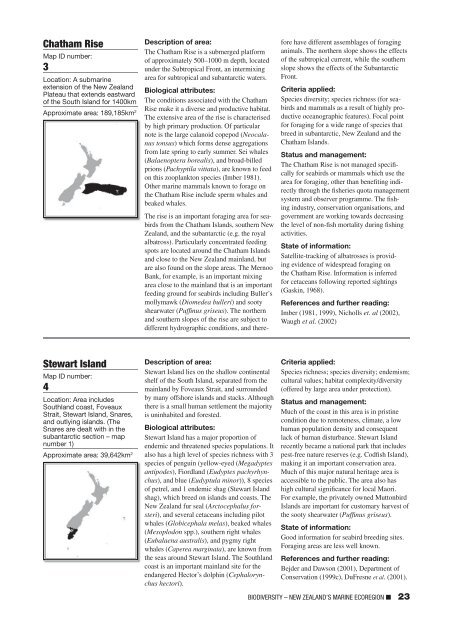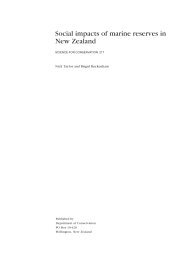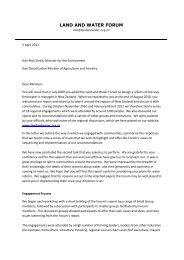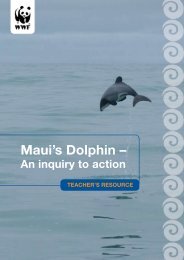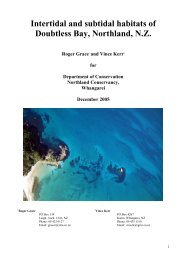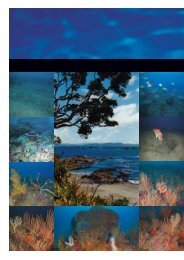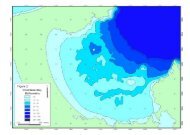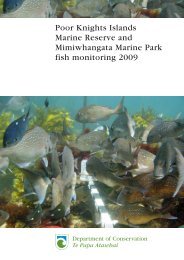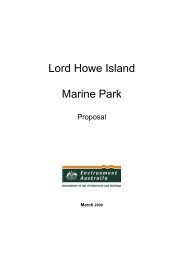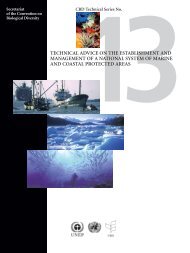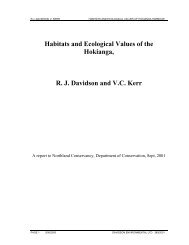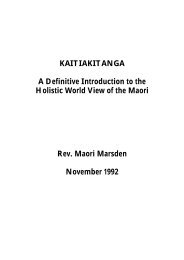WWF Shining a spotlight on the biodiversity of ... - MarineNZ.org.nz
WWF Shining a spotlight on the biodiversity of ... - MarineNZ.org.nz
WWF Shining a spotlight on the biodiversity of ... - MarineNZ.org.nz
Create successful ePaper yourself
Turn your PDF publications into a flip-book with our unique Google optimized e-Paper software.
Chatham Rise<br />
Map ID number:<br />
3<br />
Locati<strong>on</strong>: A submarine<br />
extensi<strong>on</strong> <strong>of</strong> <strong>the</strong> New Zealand<br />
Plateau that extends eastward<br />
<strong>of</strong> <strong>the</strong> South Island for 1400km<br />
Approximate area: 189,185km 2<br />
Descripti<strong>on</strong> <strong>of</strong> area:<br />
The Chatham Rise is a submerged platform<br />
<strong>of</strong> approximately 500–1000 m depth, located<br />
under <strong>the</strong> Subtropical Fr<strong>on</strong>t, an intermixing<br />
area for subtropical and subantarctic waters.<br />
Biological attributes:<br />
The c<strong>on</strong>diti<strong>on</strong>s associated with <strong>the</strong> Chatham<br />
Rise make it a diverse and productive habitat.<br />
The extensive area <strong>of</strong> <strong>the</strong> rise is characterised<br />
by high primary producti<strong>on</strong>. Of particular<br />
note is <strong>the</strong> large calanoid copepod (Neocalanus<br />
t<strong>on</strong>sus) which forms dense aggregati<strong>on</strong>s<br />
from late spring to early summer. Sei whales<br />
(Balaenoptera borealis), and broad-billed<br />
pri<strong>on</strong>s (Pachyptila vittata), are known to feed<br />
<strong>on</strong> this zooplankt<strong>on</strong> species (Imber 1981).<br />
O<strong>the</strong>r marine mammals known to forage <strong>on</strong><br />
<strong>the</strong> Chatham Rise include sperm whales and<br />
beaked whales.<br />
The rise is an important foraging area for seabirds<br />
from <strong>the</strong> Chatham Islands, sou<strong>the</strong>rn New<br />
Zealand, and <strong>the</strong> subantarctic (e.g. <strong>the</strong> royal<br />
albatross). Particularly c<strong>on</strong>centrated feeding<br />
spots are located around <strong>the</strong> Chatham Islands<br />
and close to <strong>the</strong> New Zealand mainland, but<br />
are also found <strong>on</strong> <strong>the</strong> slope areas. The Mernoo<br />
Bank, for example, is an important mixing<br />
area close to <strong>the</strong> mainland that is an important<br />
feeding ground for seabirds including Buller’s<br />
mollymawk (Diomedea bulleri) and sooty<br />
shearwater (Puffinus griseus). The nor<strong>the</strong>rn<br />
and sou<strong>the</strong>rn slopes <strong>of</strong> <strong>the</strong> rise are subject to<br />
different hydrographic c<strong>on</strong>diti<strong>on</strong>s, and <strong>the</strong>refore<br />
have different assemblages <strong>of</strong> foraging<br />
animals. The nor<strong>the</strong>rn slope shows <strong>the</strong> effects<br />
<strong>of</strong> <strong>the</strong> subtropical current, while <strong>the</strong> sou<strong>the</strong>rn<br />
slope shows <strong>the</strong> effects <strong>of</strong> <strong>the</strong> Subantarctic<br />
Fr<strong>on</strong>t.<br />
Criteria applied:<br />
Species diversity; species richness (for seabirds<br />
and mammals as a result <strong>of</strong> highly productive<br />
oceanographic features). Focal point<br />
for foraging for a wide range <strong>of</strong> species that<br />
breed in subantarctic, New Zealand and <strong>the</strong><br />
Chatham Islands.<br />
Status and management:<br />
The Chatham Rise is not managed specifically<br />
for seabirds or mammals which use <strong>the</strong><br />
area for foraging, o<strong>the</strong>r than benefiting indirectly<br />
through <strong>the</strong> fisheries quota management<br />
system and observer programme. The fishing<br />
industry, c<strong>on</strong>servati<strong>on</strong> <strong>org</strong>anisati<strong>on</strong>s, and<br />
government are working towards decreasing<br />
<strong>the</strong> level <strong>of</strong> n<strong>on</strong>-fish mortality during fishing<br />
activities.<br />
State <strong>of</strong> informati<strong>on</strong>:<br />
Satellite-tracking <strong>of</strong> albatrosses is providing<br />
evidence <strong>of</strong> widespread foraging <strong>on</strong><br />
<strong>the</strong> Chatham Rise. Informati<strong>on</strong> is inferred<br />
for cetaceans following reported sightings<br />
(Gaskin, 1968).<br />
References and fur<strong>the</strong>r reading:<br />
Imber (1981, 1999), Nicholls et. al (2002),<br />
Waugh et al. (2002)<br />
Stewart Island<br />
Map ID number:<br />
4<br />
Locati<strong>on</strong>: Area includes<br />
Southland coast, Foveaux<br />
Strait, Stewart Island, Snares,<br />
and outlying islands. (The<br />
Snares are dealt with in <strong>the</strong><br />
subantarctic secti<strong>on</strong> – map<br />
number 1)<br />
Approximate area: 39,642km 2<br />
Descripti<strong>on</strong> <strong>of</strong> area:<br />
Stewart Island lies <strong>on</strong> <strong>the</strong> shallow c<strong>on</strong>tinental<br />
shelf <strong>of</strong> <strong>the</strong> South Island, separated from <strong>the</strong><br />
mainland by Foveaux Strait, and surrounded<br />
by many <strong>of</strong>fshore islands and stacks. Although<br />
<strong>the</strong>re is a small human settlement <strong>the</strong> majority<br />
is uninhabited and forested.<br />
Biological attributes:<br />
Stewart Island has a major proporti<strong>on</strong> <strong>of</strong><br />
endemic and threatened species populati<strong>on</strong>s. It<br />
also has a high level <strong>of</strong> species richness with 3<br />
species <strong>of</strong> penguin (yellow-eyed (Megadyptes<br />
antipodes), Fiordland (Eudyptes pachyrhynchus),<br />
and blue (Eudyptula minor)), 8 species<br />
<strong>of</strong> petrel, and 1 endemic shag (Stewart Island<br />
shag), which breed <strong>on</strong> islands and coasts. The<br />
New Zealand fur seal (Arctocephalus forsteri),<br />
and several cetaceans including pilot<br />
whales (Globicephala melas), beaked whales<br />
(Mesoplod<strong>on</strong> spp.), sou<strong>the</strong>rn right whales<br />
(Eubalaena australis), and pygmy right<br />
whales (Caperea marginata), are known from<br />
<strong>the</strong> seas around Stewart Island. The Southland<br />
coast is an important mainland site for <strong>the</strong><br />
endangered Hector’s dolphin (Cephalorynchus<br />
hectori).<br />
Criteria applied:<br />
Species richness; species diversity; endemism;<br />
cultural values; habitat complexity/diversity<br />
(<strong>of</strong>fered by large area under protecti<strong>on</strong>).<br />
Status and management:<br />
Much <strong>of</strong> <strong>the</strong> coast in this area is in pristine<br />
c<strong>on</strong>diti<strong>on</strong> due to remoteness, climate, a low<br />
human populati<strong>on</strong> density and c<strong>on</strong>sequent<br />
lack <strong>of</strong> human disturbance. Stewart Island<br />
recently became a nati<strong>on</strong>al park that includes<br />
pest-free nature reserves (e.g. Codfish Island),<br />
making it an important c<strong>on</strong>servati<strong>on</strong> area.<br />
Much <strong>of</strong> this major natural heritage area is<br />
accessible to <strong>the</strong> public. The area also has<br />
high cultural significance for local Maori.<br />
For example, <strong>the</strong> privately owned Mutt<strong>on</strong>bird<br />
Islands are important for customary harvest <strong>of</strong><br />
<strong>the</strong> sooty shearwater (Puffinus griseus).<br />
State <strong>of</strong> informati<strong>on</strong>:<br />
Good informati<strong>on</strong> for seabird breeding sites.<br />
Foraging areas are less well known.<br />
References and fur<strong>the</strong>r reading:<br />
Bejder and Daws<strong>on</strong> (2001), Department <strong>of</strong><br />
C<strong>on</strong>servati<strong>on</strong> (1999c), DuFresne et al. (2001).<br />
BIODIVERSITY – NEW ZEALAND’S MARINE ECOREGION ■ 23


